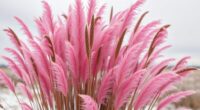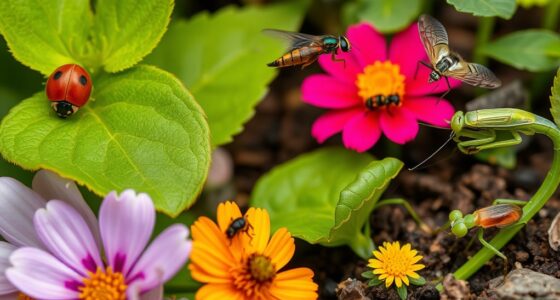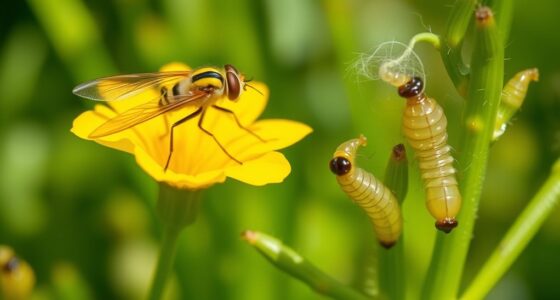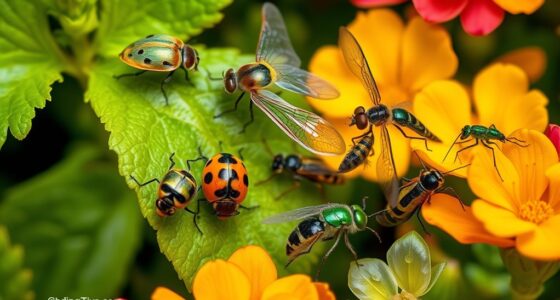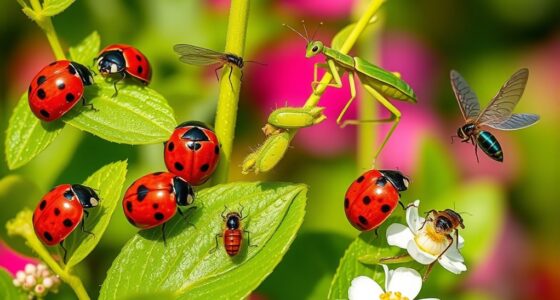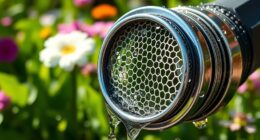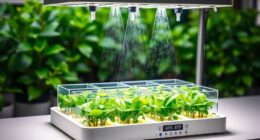To encourage lady beetles, provide a diverse garden with native plants, flowers, and shrubs that supply nectar and pollen. Leave some areas undisturbed for eggs, larvae, and pupae, and avoid using pesticides harmful to beneficial insects. Supply aphids or other soft-bodied pests naturally or through companion plants, so they have food. Creating a welcoming environment supports their full lifecycle, helping keep pests in check. If you keep going, you’ll discover more ways to support these helpful insects.
Key Takeaways
- Provide diverse native plants, especially flowering ones, to attract adult lady beetles and support their food sources.
- Avoid using pesticides to protect eggs, larvae, pupae, and adult lady beetles from harmful chemicals.
- Create habitats with dense foliage and shelter sites for overwintering and safe development stages.
- Supply pest populations like aphids naturally to provide consistent food for larvae and adults.
- Maintain a healthy garden ecosystem with natural predators and minimal disturbance to encourage lady beetle reproduction.
The Egg Stage of Lady Beetles
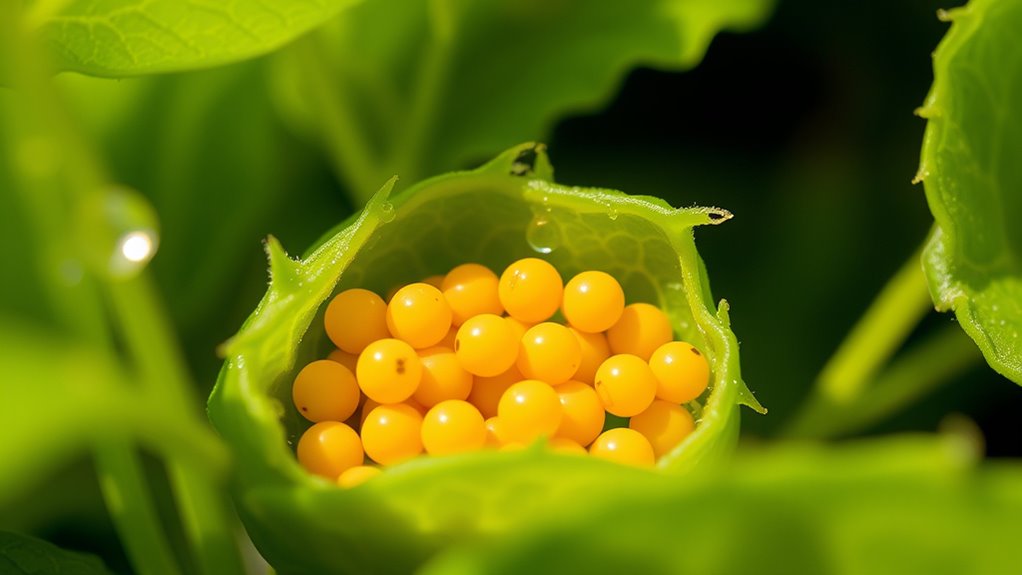
The egg stage of lady beetles begins when females lay clusters of tiny, oval-shaped eggs on the undersides of leaves. You’ll notice that their egg coloration varies, often blending with their surroundings to provide lady beetle disguise. These eggs are typically yellow or orange, helping them stay hidden from predators. Their color and placement help them blend into the foliage, making it harder for birds or insects to spot them. This disguise is essential for their survival during this vulnerable stage. As you observe your garden, look for these small eggs tucked beneath leaves—an early sign of lady beetle activity. Understanding their egg coloration and natural disguise can help you encourage their presence, supporting your garden’s natural pest control. Additionally, providing a habitat with diverse plant life can promote lady beetle reproduction and increase their population naturally.
Larval Development and Feeding Habits
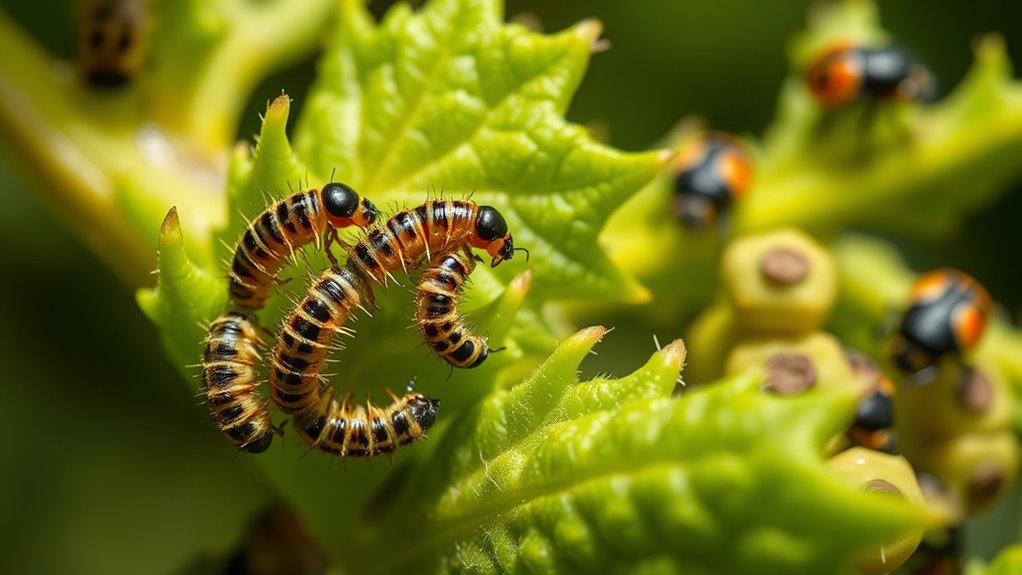
After the eggs hatch, tiny larvae emerge, marking the next stage of lady beetle development. During this larval stage, feeding is essential for growth, so you’ll notice them actively hunting pests like aphids. Larval feeding is intense; they consume large amounts of food to progress through development stages quickly. As they grow, the larvae molt several times, shedding their skin to accommodate their increasing size. Their diet remains focused on soft-bodied insects, which fuels their rapid development. Providing a garden with abundant prey and plant diversity encourages these larvae to thrive. The more suitable food sources you offer, the healthier their development stages will be, leading to more adult lady beetles ready to control pests naturally. Understanding insect diets can help you create a more balanced environment that supports these beneficial predators.
The Pupal Phase: Transformation in Progress
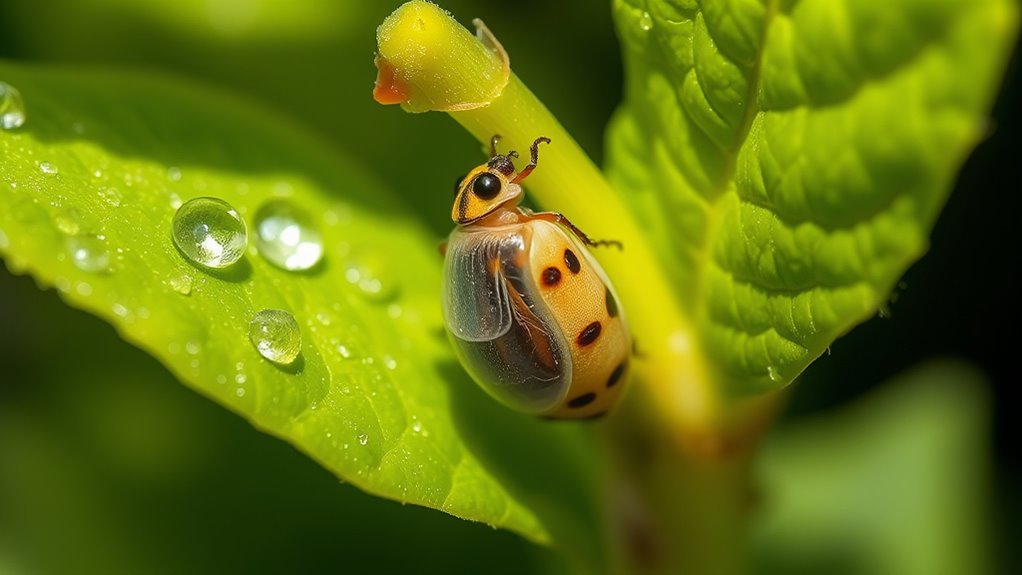
During the pupal stage, you’ll notice the beetle’s body changing shape and color as it prepares for adulthood. This transformation usually takes about a week, during which the beetle remains safely tucked away. Protecting the pupa is essential, as it’s a vulnerable time when the developing beetle is most at risk. Recognizing signs of fatigue and understanding energy depletion can help in creating a safe environment for these delicate stages.
Pupal Stage Appearance
As the lady beetle enters the pupal stage, its appearance changes dramatically as it begins to transform. During this pupal stage, you’ll notice the insect’s shape becomes more defined, and colors shift from green or yellow to darker hues. The metamorphosis process is underway, and tiny wing pads start to form beneath the skin. The pupa often looks like a small, smooth capsule, sometimes with faint patterns or spots. Here’s a quick look at what you might observe:
| Stage | Description | Key Features |
|---|---|---|
| Early pupal stage | Smooth, pale, and soft | Light color, flexible texture |
| Mid-pupal stage | Color darkens, structure becomes clearer | Wing buds appear, firm texture |
| Late pupal stage | Final transformation hints visible | Hardened shell, detailed features |
| End of pupal stage | Ready to emerge | Cracks form, ready for adult emergence |
The process of metamorphosis ensures the lady beetle transitions successfully from pupa to adult, completing its lifecycle.
Duration of Transformation
The pupal stage of a lady beetle typically lasts between 5 and 10 days, though environmental factors can influence this timeframe. During this period, the transformation from larva to adult occurs, with the beetle undergoing significant changes. If you notice lady beetle migration in your area, it might impact their development, as cooler temperatures can slow the process. The lady beetle diet during the pupal stage is minimal, as they don’t feed at this point; instead, they focus on transformation. Proper environmental conditions, such as stable temperature and humidity, help guarantee a smoother transition. Additionally, natural habitats that provide shelter and adequate resources support healthy development during this stage. After this phase, the adult lady beetle emerges, fully formed and ready to begin its role in controlling pests. Understanding this duration helps you support their lifecycle naturally.
Protecting Developing Beetles
Protecting developing lady beetles during their pupal stage is essential because this vulnerable period involves significant transformation. During this time, the beetle’s body changes rapidly as it shifts from a larva to an adult, making it highly susceptible to threats. To support their development, guarantee they have access to a healthy lady beetle diet, which includes aphids and other small insects, to strengthen their immune system. Avoid disturbing pupae by keeping your garden free of pesticides and harsh chemicals. Additionally, be mindful of lady beetle migration patterns; providing suitable habitat and shelter encourages their natural movement and reduces stress during this critical phase. Using natural and safe gardening practices helps create an environment conducive to successful pupation. By safeguarding pupae, you help boost lady beetle populations and promote a balanced ecosystem.
Emergence of the Adult Lady Beetle
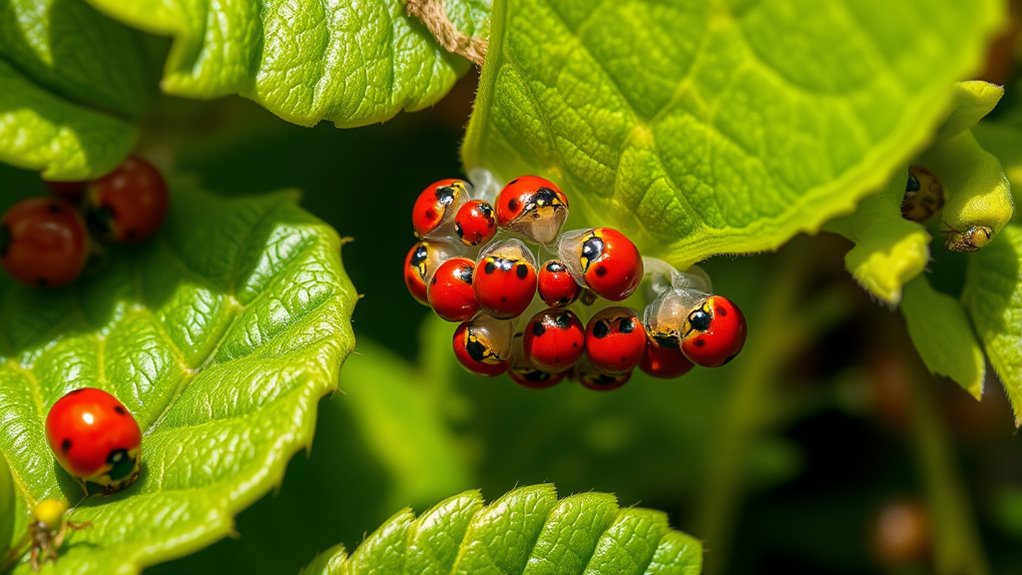
After completing their pupal stage, adult lady beetles emerge from their cases ready to begin their new role in the ecosystem. You’ll notice them quickly spreading their wings and gaining mobility. Their primary focus is on finding food and mates. Lady beetle diet mainly consists of aphids and other pest insects, helping control garden pests naturally. Once they’re active, they seek out potential partners for lady beetle mating, which often involves gentle courtship dances. During this phase, you might observe them clinging to leaves or plants. To encourage their emergence, maintain a healthy garden environment with plenty of foliage. Creating a habitat conducive to lady beetles can significantly enhance their presence. Here’s a quick overview:
| Stage | Activity | Key Focus |
|---|---|---|
| Emergence | Adult lady beetle emerges | Find food and mates |
| Lady beetle diet | Consume pests like aphids | Reproduce and thrive |
| Lady beetle mating | Courtship and reproduction | Population growth |
Recognizing Different Lady Beetle Species
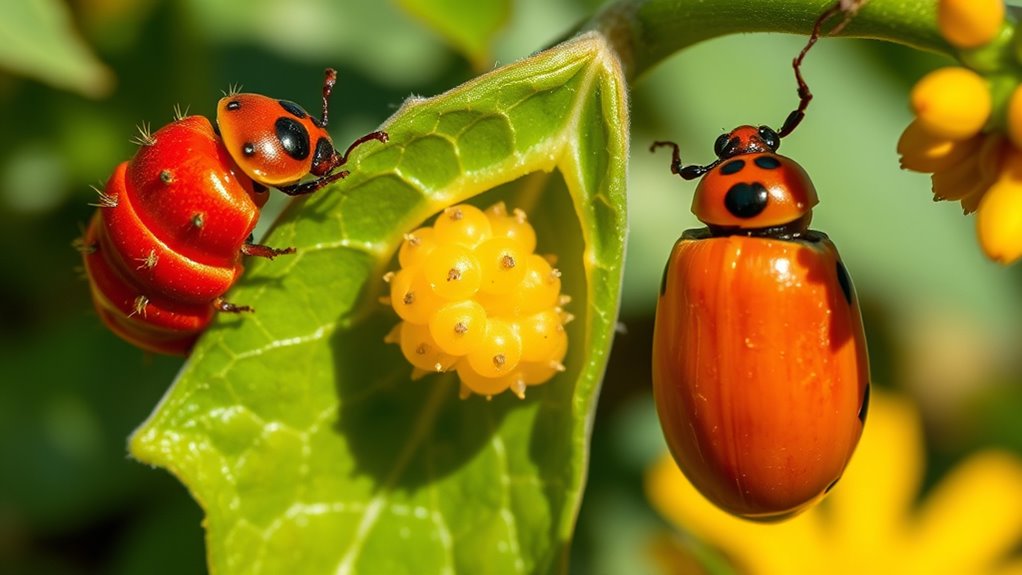
Once adult lady beetles emerge and start searching for food and mates, you’ll notice that not all are the same. Different species vary in color, spots, and size, making identification possible. Some lady beetles have bright red bodies with black spots, while others are orange or yellow with fewer spots. Their lady beetle diet mainly includes aphids and other soft-bodied pests, but some species prefer different prey. During lady beetle migration, you might see certain species traveling in large groups to find suitable habitats or food sources. Recognizing these species can help you understand their roles in your garden and how best to encourage them. Pay attention to their color patterns, size, and migration behaviors to distinguish among the different lady beetle species. Additionally, understanding AI’s role in cybersecurity can inform broader conservation efforts by protecting digital infrastructure that supports environmental research and monitoring.
The Role of Habitat in Supporting Lady Beetles
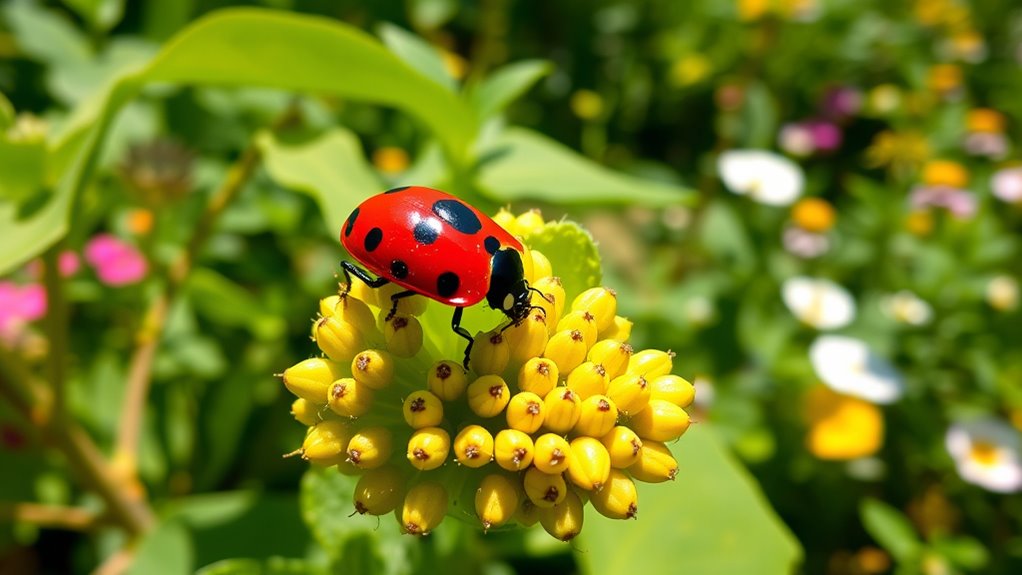
Have you ever wondered how the right habitat can boost lady beetle populations in your garden? Creating an inviting environment involves more than just planting; it’s about supporting pollinator partnerships and local garden microclimates. Lady beetles thrive in diverse habitats that offer plenty of prey, like aphids, and natural shelter. Incorporate plants that provide cover and nectar, which attract other pollinators and encourage lady beetles to stay. Maintaining a varied microclimate with shaded areas and open spaces helps regulate temperature and humidity, making your garden more hospitable. A well-designed habitat ensures lady beetles can complete their lifecycle comfortably, increasing their numbers naturally. Providing appropriate shelter and diverse plant life can further enhance their survival and reproductive success. By fostering the right habitat, you create a balanced ecosystem that benefits both your plants and these beneficial insects.
Essential Plant Choices for Attracting Lady Beetles
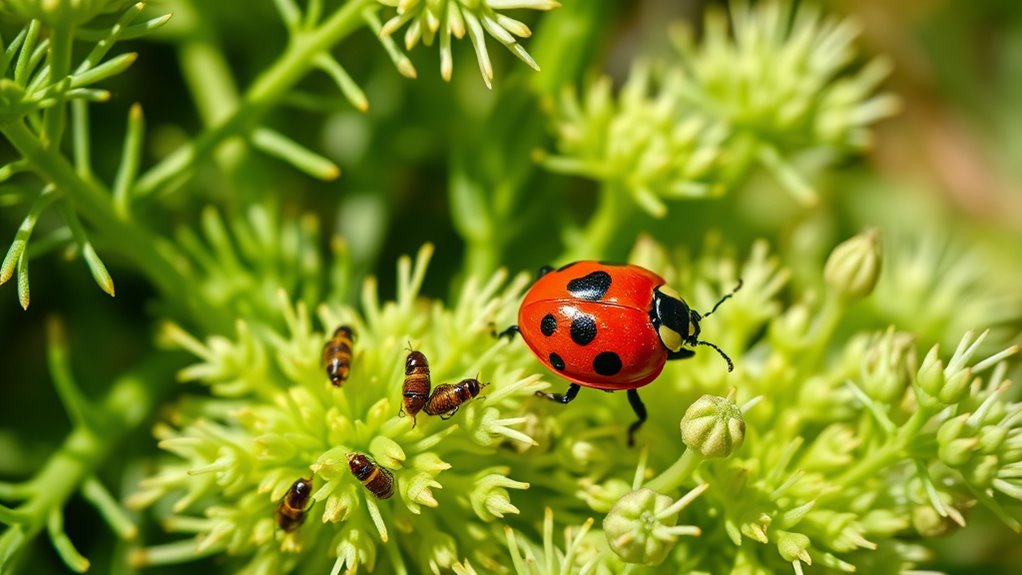
To attract lady beetles, choose native flower varieties that they naturally feed on and prefer. Incorporating a diverse plant selection ensures they have ample habitat and food sources year-round. Remember, avoiding pesticides is vital, as chemicals can harm these beneficial insects and disrupt your garden’s balance. Additionally, creating a suitable environment can encourage their presence, such as providing habitat diversity to support their lifecycle.
Native Flower Varieties
Wondering how to attract lady beetles to your garden? Native flower varieties are your best bet. They provide essential nectar and pollen, supporting native pollinators and boosting garden diversity. Choosing native plants ensures your garden becomes a welcoming habitat for lady beetles and other beneficial insects. To maximize their presence, consider planting:
- Coneflowers and black-eyed Susans, which attract pollinators and lady beetles alike
- Goldenrod and asters, offering late-season blooms for ongoing food sources
- Milkweed and other native wildflowers that support diverse insect populations
These native flowers create a stable environment that encourages lady beetles to stay and reproduce. By adding these varieties, you’ll cultivate a thriving ecosystem that naturally controls pests and promotes overall garden health.
Diverse Plant Selection
Choosing the right plants is essential for attracting lady beetles to your garden. A diverse plant selection creates a healthy lady beetle habitat, offering food, shelter, and breeding sites. Incorporate a variety of flowering plants, shrubs, and ground covers to increase plant diversity, which supports a broader range of lady beetle species. Include plants that produce nectar and pollen, as these are crucial food sources for adults. Native plants are particularly effective because they are well-adapted to your local environment and attract native lady beetles. By planting a mix of species, you not only enhance the visual appeal of your garden but also foster a balanced ecosystem that encourages lady beetle populations to thrive naturally.
Avoid Pesticides
Avoiding pesticides is essential for attracting lady beetles to your garden. Pesticide dangers can harm these beneficial insects and disrupt their natural predation of pests. To support their presence, focus on chemical avoidance and opt for organic gardening methods.
You can encourage lady beetles by:
- Planting native flowers that provide nectar and pollen
- Avoiding chemical-based fertilizers and pest controls
- Providing habitat with ground cover and mulch
Creating a Lady Beetle-Friendly Garden Environment
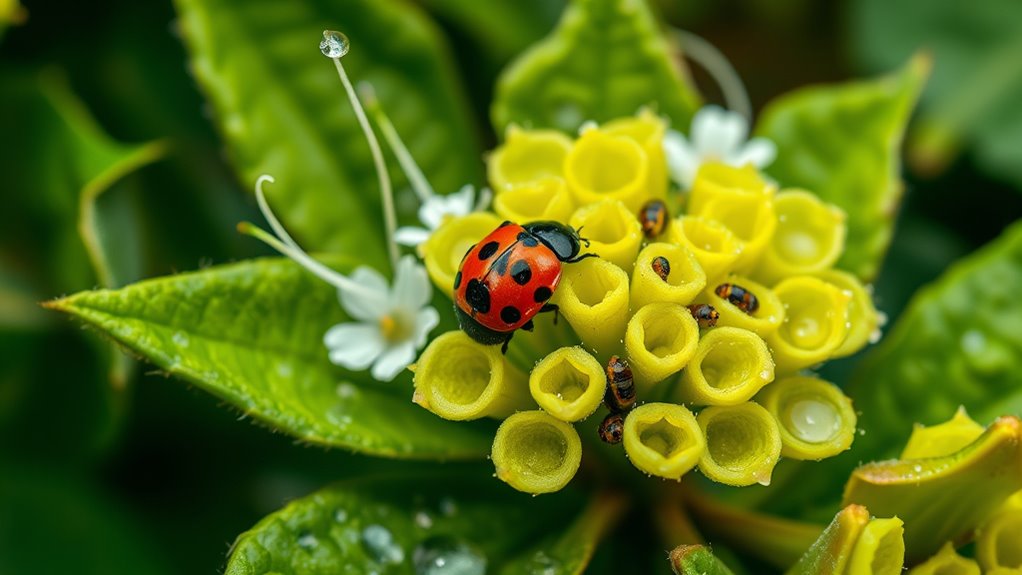
Creating a lady beetle-friendly garden environment involves providing the right habitat and resources to attract and sustain these beneficial insects. You want to create a space that offers plenty of food and shelter, encouraging lady beetles to stay. Focus on planting native flowers, herbs, and crops that support their lady beetle habitat and supply their diet of aphids and other pests. Incorporate diverse plants to ensure year-round shelter and food sources. Here’s a vivid picture:
| Habitat Elements | Benefits |
|---|---|
| Native flowering plants | Attracts lady beetles naturally |
| Dense foliage | Provides shelter and overwintering |
| Herbs like dill or fennel | Supports lady beetle diet |
| Pesticide-free zones | Keeps lady beetles safe |
| Pests like aphids | Food source for lady beetles |
Tips for Maintaining a Healthy Lady Beetle Population
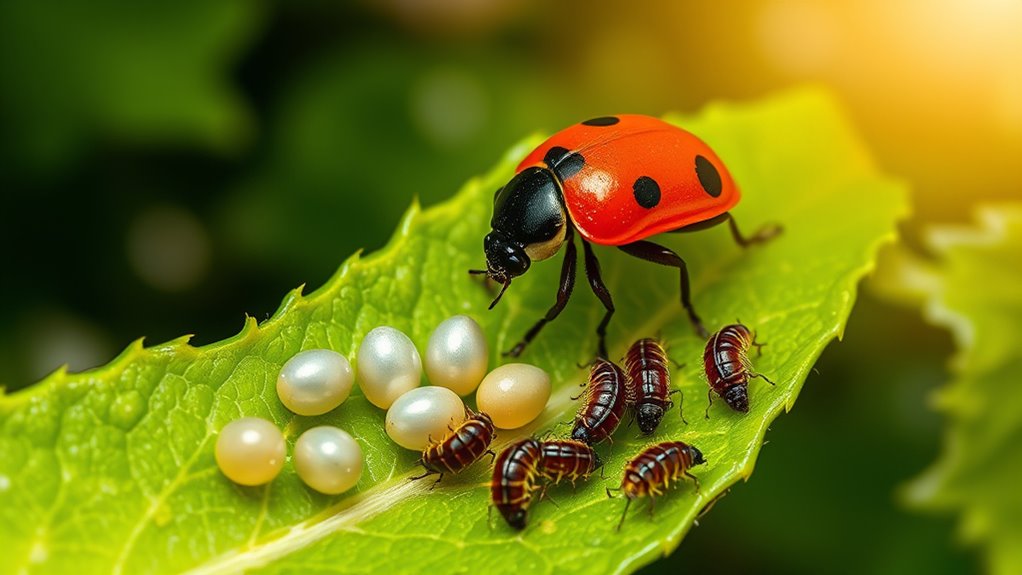
To maintain a healthy lady beetle population, you need to provide consistent food sources and a safe environment for them to thrive. A balanced lady beetle diet mainly includes aphids and other soft-bodied pests. To support their survival, avoid using broad-spectrum pesticides that could harm them or their predators.
You can also encourage natural predators of lady beetle predators, like birds and beneficial insects, to keep the ecosystem balanced.
Here are some tips:
- Plant diverse, pest-attracting plants to ensure ample food for lady beetles.
- Avoid chemical pesticides that disrupt their lady beetle diet and harm beneficial insects.
- Provide habitat cover like shrubs or ground cover to protect lady beetles from predators.
Following these tips helps sustain a thriving lady beetle community.
Frequently Asked Questions
How Long Does Each Lady Beetle Lifecycle Stage Last?
The lady beetle lifecycle duration varies, but typically, each stage lasts about a week to a month. You’ll find the egg stage lasts 3-7 days, the larva stage about 2-3 weeks, and the pupa stage roughly 4-7 days. The lady beetle lifespan usually ranges from a few months up to a year, depending on environmental conditions. Knowing this helps you understand how long each stage takes and how they contribute to their overall lifecycle.
What Natural Predators Threaten Lady Beetles?
Natural predator threats to lady beetles include birds, frogs, and larger insects like wasps. These predators often target lady beetle predation, especially when they’re larvae or eggs. You can help safeguard lady beetles by creating a garden habitat that offers plenty of cover and avoids pesticides. Encouraging a diverse ecosystem ensures lady beetles thrive and reduces the risk of natural predator threats impacting their populations.
Can Lady Beetles Be Harmful to Other Beneficial Insects?
Did you know lady beetles can sometimes harm beneficial insects? While they’re great for natural pest control, they may accidentally prey on beneficial bugs like pollinators or other predatory insects, impacting local ecosystems. This highlights the invasive species impact, where lady beetles can disrupt the balance. However, overall, they’re more beneficial than harmful, helping control pests naturally rather than relying on chemicals. Just stay aware of their role in your garden ecosystem.
Are There Specific Seasons When Lady Beetles Are Most Active?
You might notice that lady beetle behavior varies with seasonal activity. They’re most active during warmer months, typically in spring and summer, when they hunt for aphids and other pests. In fall, they tend to seek shelter for overwintering, making them less visible. Understanding these seasonal patterns helps you anticipate their activity, ensuring you encourage their presence during peak times to naturally control pests and maintain a healthy garden.
How Can I Identify Different Lady Beetle Species in My Garden?
Spotting specific lady beetle species is simple if you scan for their signature markings and habitats. Look closely at their spots, stripes, or unique patterns on their colorful exteriors, which vary by species. Consider their preferred habitats—some favor leafy gardens, others thrive on flowering plants. By observing their distinctive markings and habitat preferences, you can confidently identify different lady beetle species right in your garden, turning insect identification into an intriguing activity.
Conclusion
By understanding the lady beetle lifecycle and providing the right habitat, you can naturally control pests without chemicals. Some might think attracting lady beetles is complicated or ineffective, but with simple plant choices and a little patience, you’ll see their positive impact. Creating a lady beetle-friendly garden not only boosts your plants’ health but also supports local biodiversity. Start today—watch these beneficial insects flourish and help your garden thrive effortlessly.

